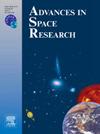基于卫星的流域土壤湿度监测:一种整合温度、反照率和光谱指数的新方法
IF 2.8
3区 地球科学
Q2 ASTRONOMY & ASTROPHYSICS
引用次数: 0
摘要
土壤含水量(SMC)是水资源管理中的一个重要参数。由于流域的广泛性,光学波长卫星遥感被认为是监测流域土壤湿度的重要方法。本研究的主要目标是开发一种基于物理线性关系的方法,该方法利用地表温度、反照率和从可见光和热波长卫星图像中获得的光谱指数来确定SMC。考虑到野外SMC数据的可用性,以及在植被稀疏地区提高SMC估算精度的公认挑战,选择美国犹他州作为选定的研究区域。以土壤气候分析网络(SCAN)在2021年4月23日、2021年10月16日、2022年4月23日和2022年10月16日收集的792个SMC测量数据为基础,编制了地面真值数据。此外,还收集了与野外数据周期相对应的288幅可见光红外成像辐射计(VIIRS)和360幅中分辨率成像光谱仪(MODIS)图像。在此基础上,建立了基于归一化植被指数(NDVI)、反照率、地表温度和裸土指数(BSI)在375和250 m空间分辨率下估算SMC的实验关系。将该方法估算的SMC与5 cm深度的实测SMC进行比较,在最优情况下,VIIRS数据的Pearson相关系数(R)为0.504,MODIS数据的Pearson相关系数(R)为0.503。该模型的Nash-Sutcliffe准则(NSE)对两种传感器的结果约为0.253,而MODIS数据的Kling-Gupta准则(KGE)为0.278,VIIRS数据的KGE为0.270。这两个数据集的均方根误差(RMSE)分别为0.023和0.027 (m3/m3)。结果表明,本研究提出的方法与已建立的三角方法相比,显示出相同或更好的结果,从而肯定了所建立的关系的有效性。本文章由计算机程序翻译,如有差异,请以英文原文为准。
Satellite-based monitoring of soil moisture in catchment basins: a novel approach integrating temperature, albedo, and spectral indices
Soil Moisture Content (SMC) is a crucial parameter in the management of water resources. Due to the expansive nature of catchment basins, satellite remote sensing in optical wavelengths is identified as a vital approach for monitoring soil moisture in these basins. The main goal of this study is to develop a methodology based on a physical linear relationship that utilizes surface temperature, albedo, and spectral indices obtained from satellite imagery in both visible and thermal wavelengths to determine SMC. Considering the availability of field SMC data and the acknowledged challenge of achieving increased accuracy in estimating SMC in regions with sparse vegetation, the state of Utah in the United States was selected as the selected study area. A dataset comprising 792 SMC measurements collected by the Soil Climate Analysis Network (SCAN) on April 23, 2021, October 16, 2021, April 23, 2022, and October 16, 2022, was compiled as ground truth data. Additionally, 288 Visible Infrared Imaging Radiometer (VIIRS) and 360 Moderate Resolution Imaging Spectroradiometer (MODIS) images corresponding to the field data period were gathered. Then, a novel experimental relationship was developed to estimate SMC based on Normalized Difference Vegetation Index (NDVI), albedo, land surface temperature, and Bare Soil Index (BSI), in spatial resolutions of 375 and 250 m. Comparing the estimated SMC using this experimental approach and measured SMC to a depth of 5 cm, the Pearson’s correlation coefficient (R) achieved 0.504 for VIIRS data and 0.503 for MODIS data in the optimal scenario. The Nash-Sutcliffe criterion (NSE) for this modeling yielded approximately 0.253 for both sensors, while the Kling-Gupta criterion (KGE) was 0.278 for the MODIS data and 0.270 for VIIRS data. The Root Mean Square Error (RMSE) was also 0.023 and 0.027 for these two datasets (m3/m3). The results suggest that the method proposed in this research, compared to the established triangular method, demonstrates equivalent or superior outcomes, thus affirming the validity of the developed Relationship.
求助全文
通过发布文献求助,成功后即可免费获取论文全文。
去求助
来源期刊

Advances in Space Research
地学天文-地球科学综合
CiteScore
5.20
自引率
11.50%
发文量
800
审稿时长
5.8 months
期刊介绍:
The COSPAR publication Advances in Space Research (ASR) is an open journal covering all areas of space research including: space studies of the Earth''s surface, meteorology, climate, the Earth-Moon system, planets and small bodies of the solar system, upper atmospheres, ionospheres and magnetospheres of the Earth and planets including reference atmospheres, space plasmas in the solar system, astrophysics from space, materials sciences in space, fundamental physics in space, space debris, space weather, Earth observations of space phenomena, etc.
NB: Please note that manuscripts related to life sciences as related to space are no more accepted for submission to Advances in Space Research. Such manuscripts should now be submitted to the new COSPAR Journal Life Sciences in Space Research (LSSR).
All submissions are reviewed by two scientists in the field. COSPAR is an interdisciplinary scientific organization concerned with the progress of space research on an international scale. Operating under the rules of ICSU, COSPAR ignores political considerations and considers all questions solely from the scientific viewpoint.
 求助内容:
求助内容: 应助结果提醒方式:
应助结果提醒方式:


